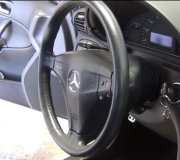Ford has always had design problems with the steering and suspension on their front-wheel-drive cars but what you're describing is not normal. Assuming nothing is bent, a failure of the steering wheel to return to center is caused either by a tight component or insufficient "caster". Caster is an alignment angle that is not adjustable on most front-wheel-drive cars, not just Fords, so it's much more likely an upper strut mount or lower ball joint is tight. To identify whether it's the upper strut mount, turn the steering wheel in both directions while the car is standing still. If you hear and feel a thumping or banging noise, that's one of the upper mounts. You can further identify which one is the culprit by reaching over the tire and wrapping your fingertips loosely around an upper part of the coil spring, then have a helper slowly turn the steering wheel. You should feel the spring rotate smoothly with the wheel. If you feel it build tension as it winds up, then suddenly snaps free and turns, that upper mount is binding.
Other than that, there are things that can go wrong with those upper mounts but it's impossible to detect until the struts are disassembled so they can be replaced. That's when the mechanic sees the deterioration and has to tell you that more parts are needed than just new struts.
Binding upper mounts are not exactly a safety hazard in themselves, but they can make the car very irritating to drive and you have to watch to be sure you're going in the direction you expect to be going after making a turn.
Tight ball joints are much less common. Ford had a big problem with them separating years ago leading to loss of control and crashes, but we don't hear so much about that anymore. Typically they are more likely to squeak over bumpy roads when they're worn out. An inspection at a tire and alignment shop will identify worn ball joints, tie rod ends, and things like that.
As for the loose feeling, worn tie rod ends again can cause that but the upper strut mounts could potentially do that too by not allowing the wheels to move around slightly as the car's suspension goes up and down. Misalignment that causes the two front tires to want to go in two different directions can cause darting. The car will follow the tire with the most weight which is usually the right one, but it will dart the other way when the left tire hits a bump and momentarily has more weight.
Also, don't confuse "loose" steering with sloppy steering. Loose means it doesn't take much effort to turn the steering wheel. That is a lack of "road feel" and can make you feel like you aren't really in control of the car. Sloppy steering means you can turn the steering wheel a bunch before the car responds. It also causes you to be constantly correcting the steering wheel to keep the car going straight. That can be very tiring.
SPONSORED LINKS
Friday, April 6th, 2012 AT 3:19 AM



